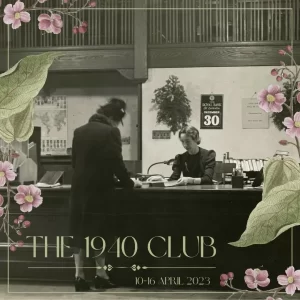 Hope I’m not jumping the gun here but the #1940Club starts next week and I’ve been gearing up and getting ready.
Hope I’m not jumping the gun here but the #1940Club starts next week and I’ve been gearing up and getting ready.
The idea is simple.
It’s a fun event with no pressure because you can choose anything from the year and read as much or as little as suits you. You can share on your blogs, Twitter, Instagram, Goodreads, in comments on our blogs or a platform of your choice. All that matters is enjoyment!
The co-hosts are Karen Langley of Kaggsy’s Bookish Ramblings and Simon Thomas from Stuck in a Book
1940 was a pretty big year for my parents. My mother was a teacher evacuated with her London school to Buckinghamshire, and my father was with the BEF in France and rescued from Dunkirk. They married on a weekend leave in November.
And of course, it was a momentous year for the world. Germany invaded and occupied Norway, Denmark, the Netherlands, Belgium, Luxembourg, and then France. The USSR annexed Estonia, Latvia, and Lithuania. The Fall of France led to the evacuation of British troops at Dunkirk (338,000 troops were rescued, a third of them French.)
It was the year of the Battle of Britain and the start of the Blitz on London and other cities in the UK. The government fell in May and Churchill – as leader of a coalition government. – delivered some of his most famous and stirring lines about blood, toil, tears and sweat and no surrender etc.
I started on my reading list for 1940 and I also made a quick search to see when the year featured on the homefront here at the Rattle and Rhu. Quite often it seems. Here are some of the highlights;
The political crisis in the British government of May 1940 was the subject of the 2018 film Darkest Hour a year that also saw Dunkirk.
I wrote:
Dunkirk tells the story of the evacuation of the British Expeditionary Force by following what happens to some representative figures – soldiers trying to get off the beach; a “little ships” civilian captain; a Spitfire pilot; the naval officer in command of the east mole. It’s good stirring stuff – well-played with parallel plots cleverly put together to tell an epic story.
Darkest Hour is about standing up to existential threats in the face of overwhelming odds. It’s the story of resistance to fascism, military aggression, and dictatorship.
It’s about some very desperate days of May and June 1940 when Great Britain was on the brink of defeat. Belgium and France fell and the defeated British army was pushed into the sea at Dunkirk. Britain stood alone and a German invasion seemed inevitable.
The British love a good defeat (Charge of the Light Brigade) and the miracle of the little ships, the rescue of the BEF and the rise of Churchillian rhetoric are defining moments in British mythology.
Dunkirk and Darkest Hour tell this story well.
Italy declared war on June 10th and the focus of the fighting turned to North Africa. The Battle of Britain and the Blitz follow on.
1940 was a busy year. And yes, very dark.
Angela Brazil was a prolific writer of boarding school stories for girls and very popular in the first half of the C20th. But it wasn’t only girls who read them. Arthur Marshall had a wonderful story about being on the beach at Dunkirk:
Because of my admiration for Angela Brazil, I chose to imagine that we were all in a vast girls’ school: Headmistress, Miss Gladys Gort; School colours, khaki and black; School motto, Don’t Look Back Or You Might See Something Nasty. All the junior girls were dead nuts on that new and dashing hockey mistress, Miss Brenda Montgomery”.
“Gladys” Gort was of course Field Marshal John Standish Surtees Prendergast Vereker, 6th Viscount Gort, VC, GCB, CBE, DSO& Two Bars, MVO, MC commander of the British Expeditionary Force sent to France in 1939.
And Brenda the “dashing hockey mistress” was Field Marshal Bernard Law Montgomery, 1st Viscount Montgomery of Alamein, KG, GCB, DSO, PC, DL
The novelist Kate Atkinson set her novel Transcription in the years 1940 and 1950.
I was so taken with the book I wrote a second post that focussed on all the food and drink – the great, the OK, and the downright disgusting.
In 2017, I wrote two posts about the Women’s Land Army and 1940, one of which includes a fascinating short story by Diana Gardner – The Land Girl, – first published in Horizon in December 1940. It’s an extraordinary story of domestic warfare, sexual politics, and social class. Una is a land girl who lives with the Farrants on their farm. It’s clear she is somewhat troubled, willful, spoilt, and supercilious.
A clash of social class is revealed by her condescension at the decor of the cowhand’s “parlour” and his wife’s teeth. But she enjoys the good brown ale at “The Drovers” and finds Mr. Farrant not bad-looking. It’s a recipe for disaster.
The war with Mrs. Farrant begins over the sugar, moves on to spilt tea and escalates from there.
“ My good woman,” I said. “ I haven’t taken up farming to be ordered about by you.”
“This is my house and I’ll be obeyed in it.”
There’s an open warfare confrontation over snow and boots and Una vows to pay her back. How she does, makes for a chilling story as she cold-heartedly goes about getting her revenge. Well – read it for yourself.
Diana Gardner was also a painter and an illustrator. She lived near Virginia and Leonard Woolf in Rodmell, Sussex, and apparently, Woolf was rather sniffy about Gardner’s “sheep-witted’ father. I used her woodcut of German planes flying low over Sussex for this story about the raid known as The Hardest Day.
April 1940 – before Dunkirk, the Battle of Britain and the Blitz – saw the first edition of The Land Girl a publication for and about The Women’s Land Army. I open this account with a poem by Sylvia Plath.
In 1940, many in England prepared for imminent invasion.
Virginia and Leonard Woolf knew they had reason to fear. They were well aware of Nazi atrocities towards civilians during invasions and that – as prominent intellectuals – they would be targets. Additionally, Leonard was Jewish.
They had the plan to kill themselves. They stored an extra can of petrol in the garage and planned to asphyxiate themselves with exhaust fumes if Germany invaded. Virginia Woolf’s diary entry for May 15th, 1940:
“We discussed suicide if Hitler lands. Jews beaten up. What point in waiting? Better to shut the garage doors. This is a sensible, rather matter of fact talk…No, I don’t want the garage to see the end of me. I’ve a wish for 10 years more, & to write my book wh. as usual darts into my brain.”
Leonard Woolf also had a backup plan. In June 1940, he obtained a vial of ‘protective poison’ (a lethal dose of morphia) from Virginia’s brother, Adrian Stephen, who was a psychiatrist.
This next post includes words by Virginia Woolf and The Leaning Tower, A paper read to the Workers’ Educational Association, Brighton, May 1940.
Writing and speaking as another war was beginning to tear the world apart – Woolf reflected on the profound impact of the Great War of 1914-18. In her, essay Woolf sees WW1 as a defining moment that tore a wound in the timeline of history. No longer remote and distant, war was close to home and even closer in 1940.
Writers – who during the Napoleonic era had been able to ignore the impact of war – no longer could do so. This was true not only for the soldier-poets drawn directly into the conflict but also the non-combatants like T.S. Eliot, D.H. Lawrence, and Woolf herself. All needed to grapple with the enormity and proximity of the war and its social and cultural impact.
In a Covid-related post and to counter the ever-frothing anti-vaxxer brigade, I wrote about the introduction of the vaccine for diphtheria. In 1940, diphtheria became the first vaccine to be offered free to British children on a national scale. It was a public health game-changer reducing the caseload from over 46,000 in 1940 to just 962 in 1950, and deaths from 2,480 to 49.
Like the Woolfs, George Orwell was on Hitler’s blacklist of politicians, trade unionists, socialists, intellectuals, artists, scientists writers, journalists, and emigres of all kinds who were to be immediately arrested if Germany successfully invaded Britain.
After the war, a copy of the Sonderfahndungsliste G.B. (Special Search List Great Britain) – was discovered among the papers of Heinrich Himmler. You can see and search the list here.
This post describes an encounter Orwell had with a young artist sheltering from the Blitz at the Café Royal. The young man is under the dangerous delusion that in a time of autocracy and totalitarianism, the individual can remain free inside.
Not everyone felt the same way. The Scottish poet Hugh MacDiarmid believed that a Nazi invasion of Britain would benefit Scotland. In June 1940, he wrote to fellow communist Sorley MacLean: “Although the Germans are appalling enough, they cannot win, but the British and French bourgeoisie can and they are a far greater enemy. If the Germans win they could not hold their gain for long, but if the French and British win it will be infinitely more difficult to get rid of them.”
Erika Mann was under no delusion about the power of the state to control life and thought. The Nazis had taken away her German citizenship and when she arrived in New York in 1940 she did so as a British citizen and as the wife of W. H. Auden.
Auden and his friend and former lover Christopher Isherwood had arrived in New York in January of 1939.
In 1940, Auden was in love with Chester Kalman and living in Brooklyn Heights. He called the house at 7, Middagh Street a “menagerie” for its revolving cast of bohemian writers, musicians, and artists. Anais Nin called it the February House because several of the residents had birthdays in that month. The motley and talented crew included Jane and Paul Bowles, Benjamin Britten and Peter Pears, Carson McCullers, Gypsy Rose Lee, and Richard Wright and his wife and daughter.
At Middagh Street, Auden apparently took on the role of the grown-up – setting end times for partying, times for meals, and presiding at the head of the table.
Alcohol was freely imbibed to excess, individual melodrama was on full display, and personal and political squabbles and jealousies were frequent.
I wrote about the remarkable Anna Kavan in a post about the Chicago artist Gertrude Abercrombie whose surrealistic and symbolic world brought Kavan’s writing and art to mind. Kavan’s wartime stories are collected in I am Lazarus, (1945). They are the perfect antidote to the mindless cheerfulness of Blitz nostalgia. Kavan – the pacifist and anti-fascist – is having none of that delusion. Her Asylum Piece (1940) about mental illness, her breakdown, and institutionalization was published in 1940.
Meanwhile, back in London, my grandmother’s friend, the Czeck refugee Fritz Stingl. was working as a waiter at the Savoy Hotel. The luxurious gas-proof, bomb-proof, air-conditioned, and sound-proof Savoy air raid shelter was the perfect symbol of the class divide. To make that point, East-End Communist leaders led a sit-down protest at the Savoy to protest shelter conditions and the refusal of the government to open the underground stations as bomb shelters.
A little further west, in Lowndes Square, Belgravia, the writer Winifred Ellerman – better known as Bryher – arrived from Switzerland in September 1940 to spend the war years with her friends in London and with her long-term partner and lover the poet H. D, (Hilda Dolittle). Bryer wrote a memoir of those years and an interesting novel – Beowulf – centered on the local tea shop – the Warming Pan – and its owners and clientele. It was published after the war but it is set in 1940. I wrote about the war memoir The Days of Mars here. Her perspective on the war is not the one that is commonly shown in popular books and films about the war.
There’s more about the intersections between wartime politics and writers in this post – one of two – that told the story of what happened when PG. Wodehouse got himself arrested and imprisoned by the Nazis in 1940. He stepped into deep shit with a certain section of outraged British society in a pile-on led by A.A.Milne. George Orwell came to his defense.
Falling Wall tells the story of one of the worst nights of the London Blitz. The featured image below showed the incident in Shoe Lane in the City of London on the night of 29 December 1940, where today Goldman Sachs has its offices. The artist Leonard Rosoman and the writer William Sansom were both in the crew that fought the blaze that threatened to engulf St.Paul’s Cathedral. You can read Sansom’s powerful account “The Wall” on the post
In early 1940 T.S. Eliot completed East Coker, the second part of his work later known as The Four Quartets. He wrote the third section later in the year.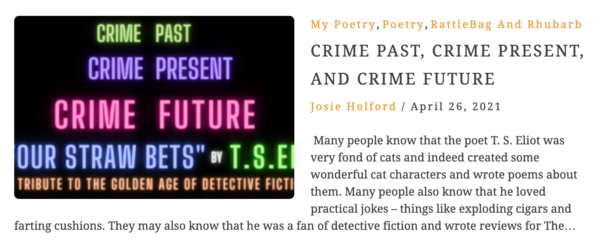
Eliot completed ARP training, received a whistle but not a uniform, and served as a fire watcher. In a letter to John Hayward he has advice for those caught in an air raid:
“The first thing to do when you hear the Syrens, or the gun fire preliminary (as last night I am sorry to say the sirens) is to have a good Piss: after that you are ready for the Jerry.
On the last day of the year, he wrote about his ARP experience to his friend and spiritual mentor Geoffrey Curtis:
…being a nervous person, with little self-confidence in my resourcefulness in emergency, I was always in an agony of apprehension of having to go out and deal with some half-mangles human being and probably do the wrong thing …Such worries were very very exhausting, though I found to my surprise, on retiring, that the mixture of fear and excitement was a kind of drug which I missed …Also i have just completed another poem (Dry Salvages) to go with “East Coker”, and contemplate a fourth to complete the sequence. the unwritten one is provisionally, “Little Gidding”. from The Letters of T.S.Eliot 1940
Working at the publisher Faber and Faber, Eliot was a literary gatekeeper. I’ll be writing about at least one of the books he passed for publication for the #1940Club.
It’s 1940.
What was happening in your family? What do you know? what don’t you know?
What is happening in the lives of the writers, poets, artists thinkers that you admire or know about from that time?
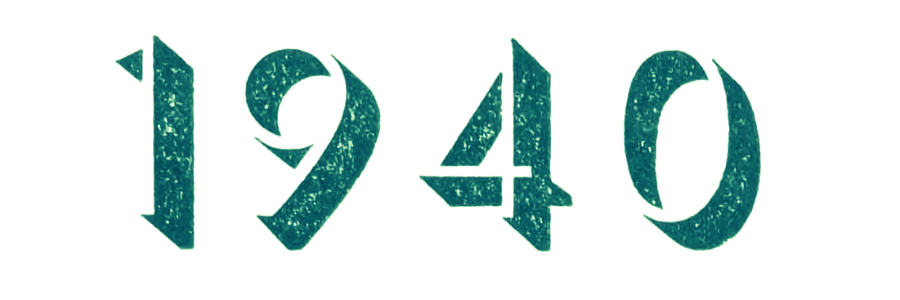
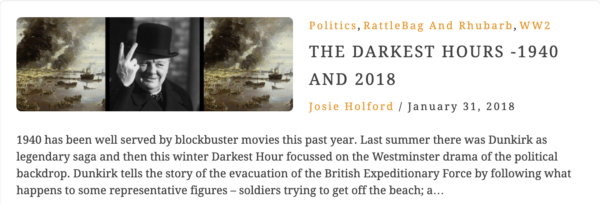
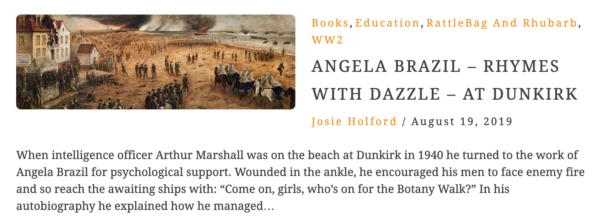

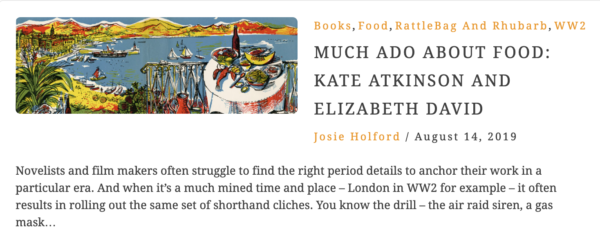

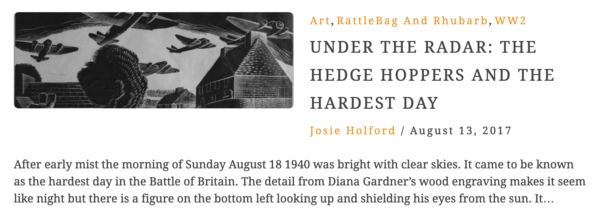


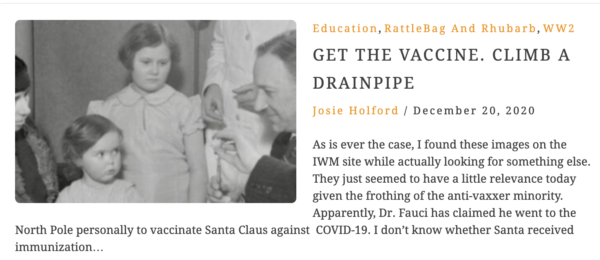
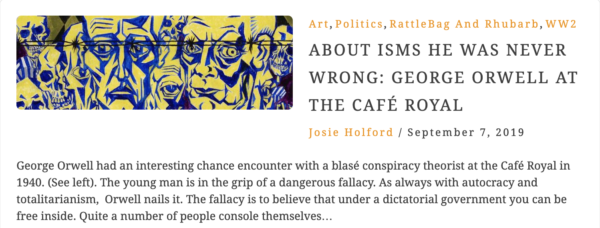
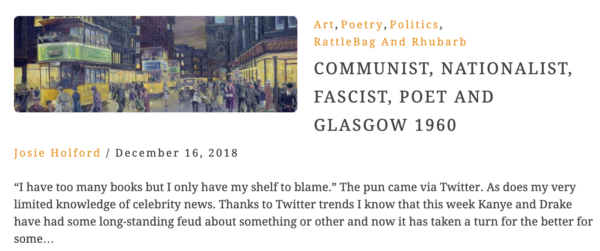
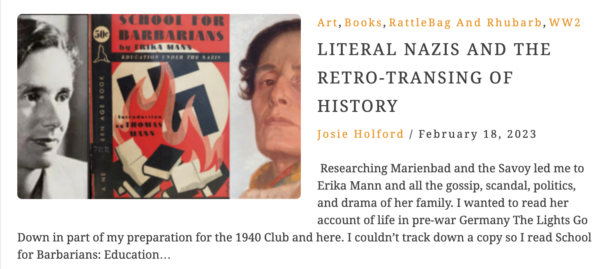

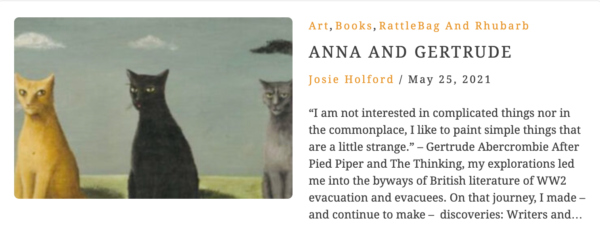
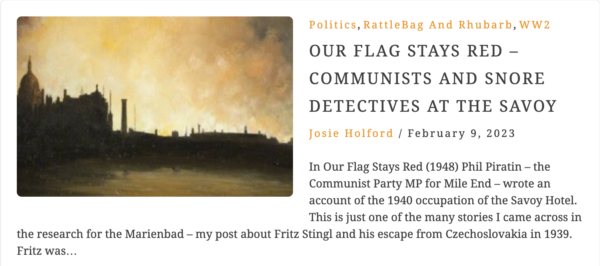
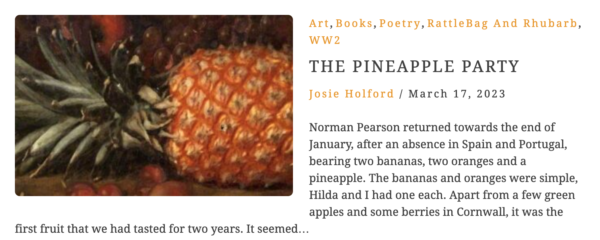
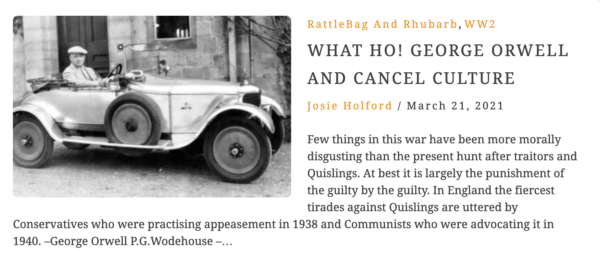
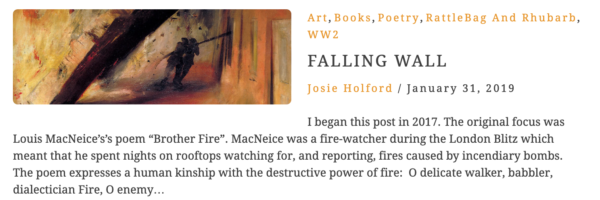


The last war is mentioned only in passing in the 1940 piece I’ve chosen to review for this coming week of retrospective reading – Borges’ ‘Tlön, Uqbar, Orbis Tertius’. Actually this is my second read of it, and I’ve virtually completed my review, so I’ve cheated a bit but as I have so much else currently on the go I just have to go with the flow of what I manage to complete… Still, I’m grateful for this overview, thank you!
It was a very busy year all round!
Looking forward to your Borges post.
Fascinating post, Josie – thank you for all that info about 1940. Particularly interestef that you picked our Diana Gardner – I was lucky enough to meet her once, fascinating woman!
How wonderful to have met Diana Gardner! I loved that Land Girl story – wicked good stuff. I found it via Horizon – founded of course in 1940 and a trove of great items and interesting characters (Julian Maclaren Ross, Orwell v. Frank Richards on “Boys Weeeklies ” et al etc.) On that more next week I hope.)
A wonderful glimpse into the year and what was happening, Josie, thank you. Just looking at the books that were published in 1940 in the UK and US, it’s fascinating to see how many are still popular and a part of our reading lives.
Then looking further afield to Eastern/Central Europe and the Soviet Union the events happening in those countries was momentuous and could generate an infinite number of incredible stories and we know only a tiny sliver of them.
Absolutely. Mine is a very narrow shaft of light in big wide world.
And an enlightening one it is too. I’m afraid my curiosity often automatically pivots to that part of the world that intrigues me so much and asks, ‘but what about…?’
It’s a good instinct.
This is great and I shall be reading all of these. I have a fascination for that time and those people. For every story told, how many thousands there must have been. We must hold on to those that managed to be told.
1940 is not so long ago and almost everyone knows someone who was alive then and will have a story to tell. Seems to me that knowing our pasts – individual, familial, and collective – provides the best guide to what lies ahead. I always love when you delve into your personal history on your blog Cats in Cambridge. https://catsincambridge.net/ (And then of course I also love the up-to-the-moment road trips, cat and other animal adventures, and animal dialogues and commentary.
Josie, I didn’t know about your other writings which sound really interesting. Don’t you think you could get them published together?
My life in 1940? I was three and was most interested in my doll with a china head and cloth body with eyes that would roll back and forth in her head. In Iowa the war was far away, but so was my father. I tended to think that families only had mothers present by the time he came home in 1946.
Happy you found them interesting Carol. Just me rambling on as per usual.
But thanks for that image of you age three and your doll with the china head and rolling eyes. Very sophisticated toy for the time. And now I want to see pictures of you from that time. You must have some…
High praise John, for what is basically just a recap of life gone by! Thanks.
And just think of all the others – writers, artists, thinkers, and just people and what they were doing and enduring (or not) in that momentous year.
So many stories: This one comes to mind because Bryer mentions him in her memoir because he was a friend: Walter Benjamin who crossed the French–Spanish border and arrived in Catalonia in September 1940. The Franco government had canceled all transit visas and ordered the Spanish police to return such persons to France, including the Jewish refugee group Benjamin had joined. This would have ended Benjamin’s plans to travel to the US. Expecting repatriation into Nazi hands, Benjamin took an overdose of morphine.
What an exhilarating literary and political tour of the time – I’ll read this again in the morning as I haven’t yet taken it all in. Fascinating and revealing. Thanks, Josie.
John Hodgson´s last blog post ..Pro-life Wyoming